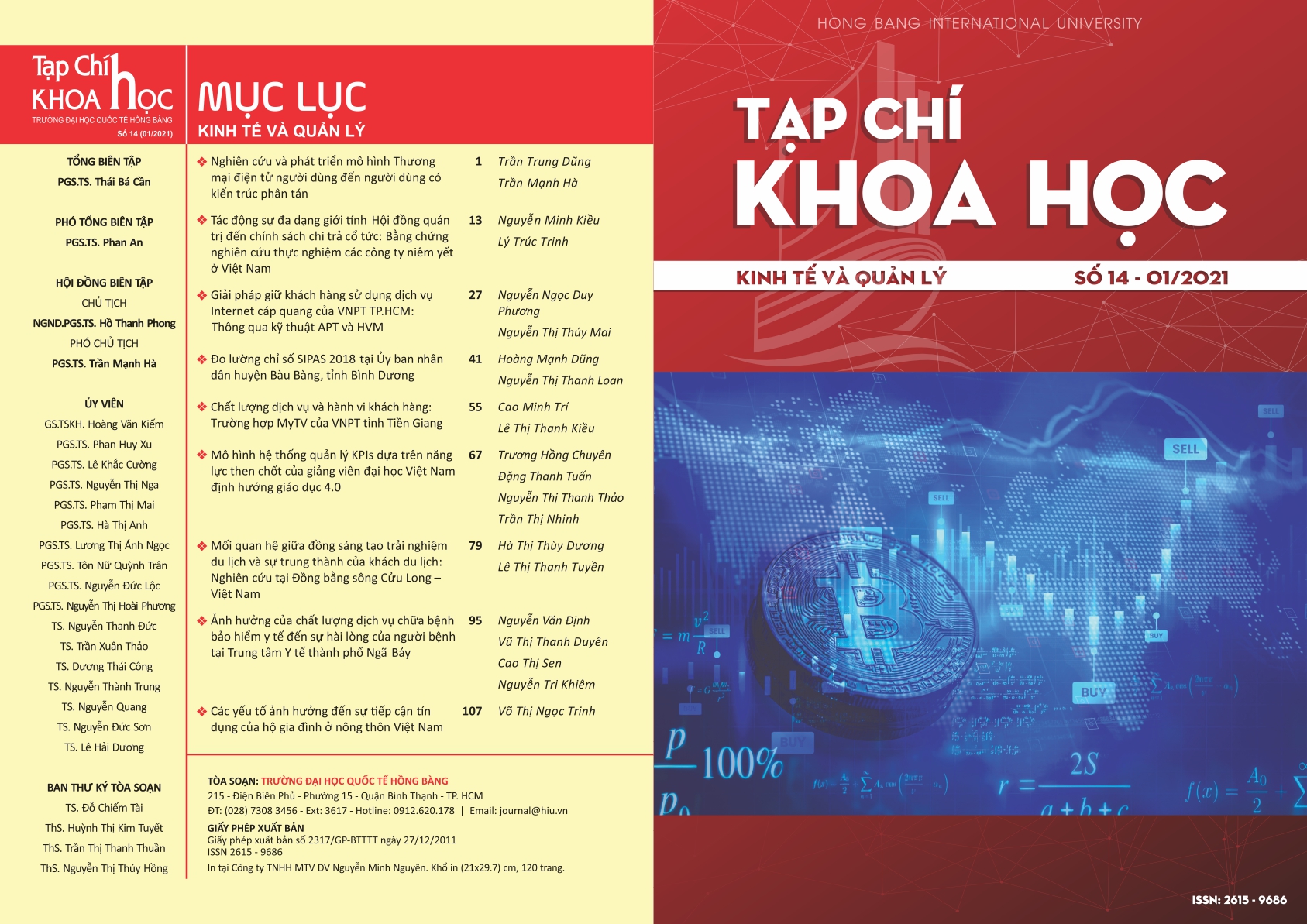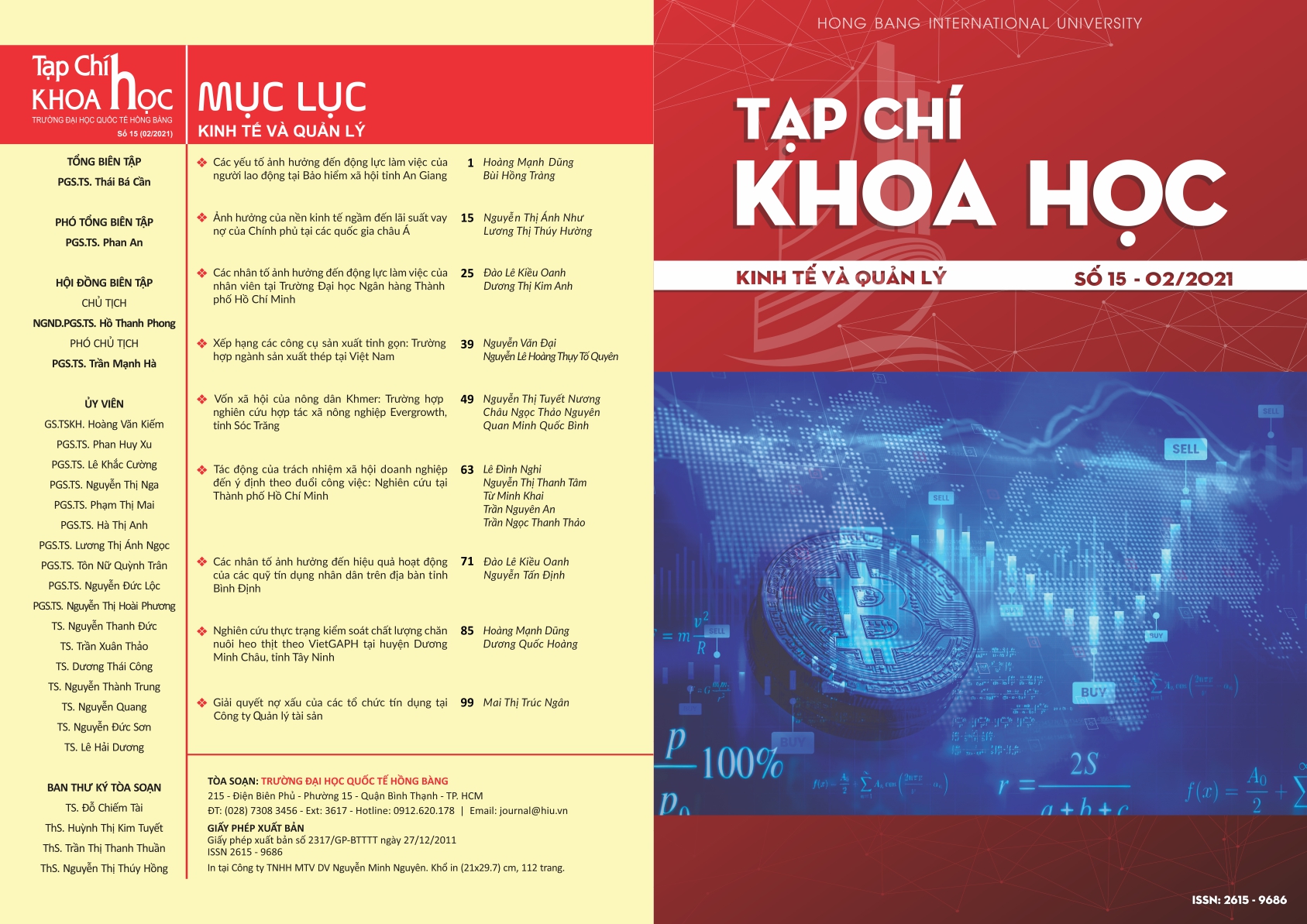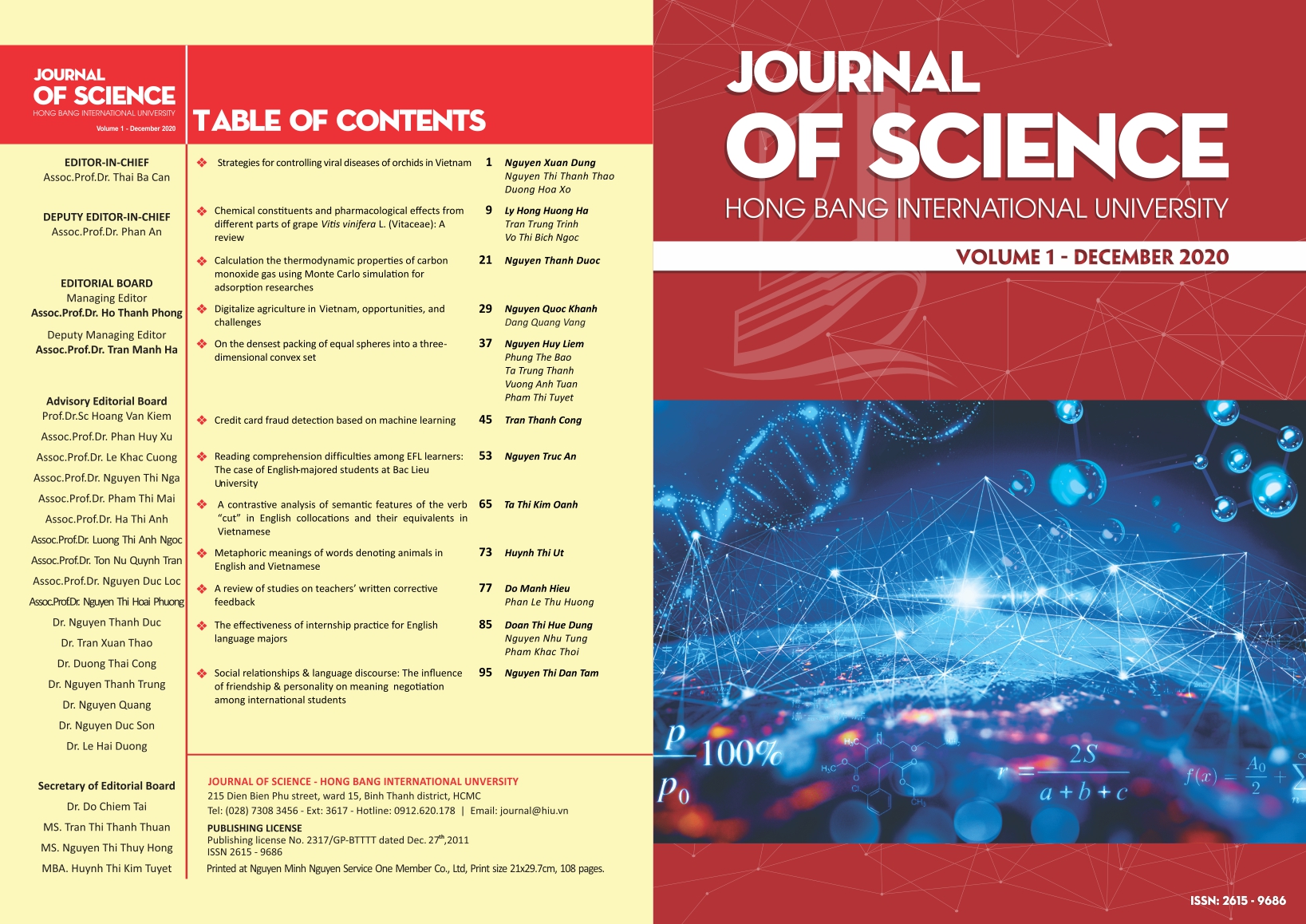
Dear authors and readers!
Hong Bang International University is a multi-disciplinary human resource training centre, serving the needs of Ho Chi Minh city's socio-economic development in particular and the country in general.
Associated with improving the quality of training, scientific research has always been interested in the University. With the approval of the Central Propaganda Department, on December 27, 2011, the Ministry of Information and Communications granted the Press Publishing License No. 2317 / GP-BTTTT, allowing Hong Bang International University to publish the Journal. At the same time, Science Magazine was also approved by the National Department of Science and Technology Information under the Ministry of Science and Technology to issue the international standard code ISSN 2615-9686 to the University's Science Journal.
Science magazine was born to meet the needs of research, exchange, and introduction of scientific and technical achievements of the University and related agencies, research institutes, universities, and then confirmed. The exciting results of Hong Bang International University in the field of training and science and technology activities.
The magazine would like to receive more new articles with more diverse and more prosperous topics, scholarly exchange articles, raising current controversial issues to promote continuing the multifaceted renovation in Vietnam.
To deserve the trust of our readers and respond to the magazine's mission, we look forward to receiving scientific articles from professors, associate professors, doctors, masters who are teaching in the school. ; graduate students, graduate students, students of the University and domestic training institutions, and scientists from all over the region.
Hong Bang International University Science Magazine would like to thank the authors and scientists who have submitted their articles to the magazine and always look forward to welcoming your enthusiastic cooperation.
We wish the authors and readers health, happiness, and success.
Best regards.
SECRETARY OF EDITORIAL BOARD – HONG BANG INTERNATIONAL UNIVERSITY
| Editorial department: Level 24 – Ship of Knowledge Building |
| No. 215 Dien Bien Phu, Ward 15, Binh Thanh District, HCMC |
| Tel: (028) 7308 3456 – Ext: 3617 |
| Hotline: 0912 620 178 |
| Email: journal@hiu.vn |
| Website: https://hiu.vn/tap-chi-khoa-hoc/ |
|
EDITOR-IN-CHIEF |
Advisory Editorial Board |
|
Assoc.Prof.Dr. Thai Ba Can |
Prof.Dr.Sc Hoang Van Kiem |
|
DEPUTY EDITOR-IN-CHIEF |
Assoc.Prof.Dr. Phan Huy Xu |
|
Assoc.Prof.Dr. Phan An |
Assoc.Prof.Dr. Le Khac Cuong |
|
EDITORIAL BOARD |
Assoc.Prof.Dr. Nguyen Thi Nga |
|
Managing Editor |
Assoc.Prof.Dr. Pham Thi Mai |
|
Assoc.Prof.Dr. Ho Thanh Phong |
Assoc.Prof.Dr. Ha Thi Anh |
|
Deputy Managing Editor |
Assoc.Prof.Dr. Luong Thi Anh Ngoc |
|
Assoc.Prof.Dr. Tran Manh Ha |
Assoc.Prof.Dr. Ton Nu Quynh Tran |
|
Assoc.Prof.Dr. Nguyen Duc Loc |
|
Advisory Editorial Board |
Secretary of Editorial Board |
|
Assoc.Prof.Dr. Nguyen Thi Hoai Phuong |
Dr. Do Chiem Tai |
|
Dr. Nguyen Thanh Duc |
MS. Tran Thi Thanh Thuan |
|
Dr. Tran Xuan Thao |
MS. Nguyen Thi Thuy Hong |
|
Dr. Duong Thai Cong |
MBA. Huynh Thi Kim Tuyet |
|
Dr. Nguyen Thanh Trung |
|
|
Dr. Nguyen Quang |
|
|
Dr. Nguyen Duc Son |
|
|
Dr. Le Hai Duong |
A. WRITTEN CONTENT
Introduction to scientific achievements, initiatives, and experience in teaching and research;
Publication of research results, scientific research topics, and technology deployment;
Disseminate experiences in management and organization of science and technology activities of officials, lecturers, and students inside and outside the school;
Introduce the specific cultures of the ethnic groups at home and abroad;
Introduce discoveries in the field of Social Science, Natural Science at home and abroad.
B. RESPONSIBILITIES OF AUTHOR
Authors must ensure that the submission for the Hong Bang International University Science Journal has not been published/published in other journals, papers, or electronic publications.
Editors do not return manuscripts of undeleted posts.
The author is not allowed to submit articles in other journals until the final approval decision is “Disapproval of the post" of the Hong Bang International University Science Journal.
If the article belongs to a group of authors, in a post to the Editors need to indicate: who is the corresponding author?
C. WRITTEN RULES
C1. Request Posts
Articles are presented from 10 to 15 pages of A4 size paper, typed by a computer on MS Word software, Unicode encoding, Times New Roman font, size 12.
Format top, bottom, and left margins: 30mm, right margin: 25mm, line spacing 1.5 lines, the space between paragraphs is 6pt.
Formula Math, Physics, Chemistry,…. using MathType, ChemBioDraw, … the number of the formula to type on the right.
Tables, images, and charts must have names. Image quality should be good and the histogram should be clear. Picture size not more than 7x14cm, PNG, JPG, WMF format. The image and chart names are both referred to as “Picture" and are located below. The name of the board is at the top. Pictures and tables must be numbered. In case the author uses the chart, but the chart is converted to word from MS Excel software, the author is required to transfer the data file (excel file) of the chart to the Editorial Board when transferring the post.
C2. Article structure
Title: The title of the article includes Vietnamese and English; The title should be clear and concise.
Full name of author or group of authors: record right below the title of the article, it is necessary to record the full name and full name of the article, academic titles and qualifications of all authors of the article (do not use the phrase “et al. ”), Same name of institution/working unit, email and contact phone (if any) of each author. The main author and corresponding author (corresponding author) of the article should clearly state their title, phone number, and email for easy communication.
Abstract: about 100 – 150 words for each part in English and Vietnamese, generally reflecting the main content of the article and clearly showing the results, contributions, and new points of the article;
Keywords: 3 – 5 words specific to the topic of the article;
For numeric data in the article: use a period (.) For the number of decimals, and a comma (,) for the number of thousands. Example: 14,230.85
Content of the article: the article must clearly mark the following sections:
Introduction / Introduction / Problems: Research overview; the need of the research problem, the main content that the article will focus on solving.
Content, experiment, research overview, research method: clearly present research overview, and related theoretical basis; theoretical framework or analytical framework used in the paper; The author can choose either qualitative or quantitative research methods or both, in which research model and hypotheses need to be presented.
Results and discussion: interpretation, analysis of new findings; draw out the general relationship, the relationship between the author's research results with other findings in previous studies; For several articles of advice, policy criticism, expert opinion …, focus on assessing the current state of the research problem.
Conclusion / recommendation: making conclusions or / and recommendations based on research results.
Sections, sub-categories; correct in scientific style, obey current spelling, use terminology, and symbols.
References are made according to the IEEE standard (refer to the IEEE Citation Style Guide for more details on IEEE English standards). Both articles are in Vietnamese and English; Each reference begins with the author's last name, followed by the author's middle and first name. The middle name and the author's first name in a foreign language article may be abbreviated (surname and middle name are separated by commas), but in a Vietnamese article, it can be written in full.
The acknowledgment part should be briefly presented at the end of the article, before the reference (if any).
D. POSTED POSTS
The posts must be free of spelling or typographical errors.
Published posts are those that meet the criteria and requirements guided in the previous sections and are approved by reviewers and Editors. For this purpose, the Editors may ask the author of the post to answer and correct all questions in the article.
Contact information: The author sent to the Editorial Board the article via email: journal@hiu.vn
JOURNAL OF SCIENCE – HONG BANG INTERNATIONAL UNIVERSITY
Address: 215 Dien Bien Phu street, ward 15, Binh Thanh District, HCMC.
Tel: (028) 7308 3456 – Ext: 3617
Hotline: 0912 620 178
Email: journal@hiu.vn
Website: https://hiu.vn/tap-chi-khoa-hoc/
Editorial Board
Journal of Science – Hong Bang International University applies a closed review process, which means that reviewers are not informed about the author of the article and vice versa.
The process of reviewing and posting is described through the following diagram:
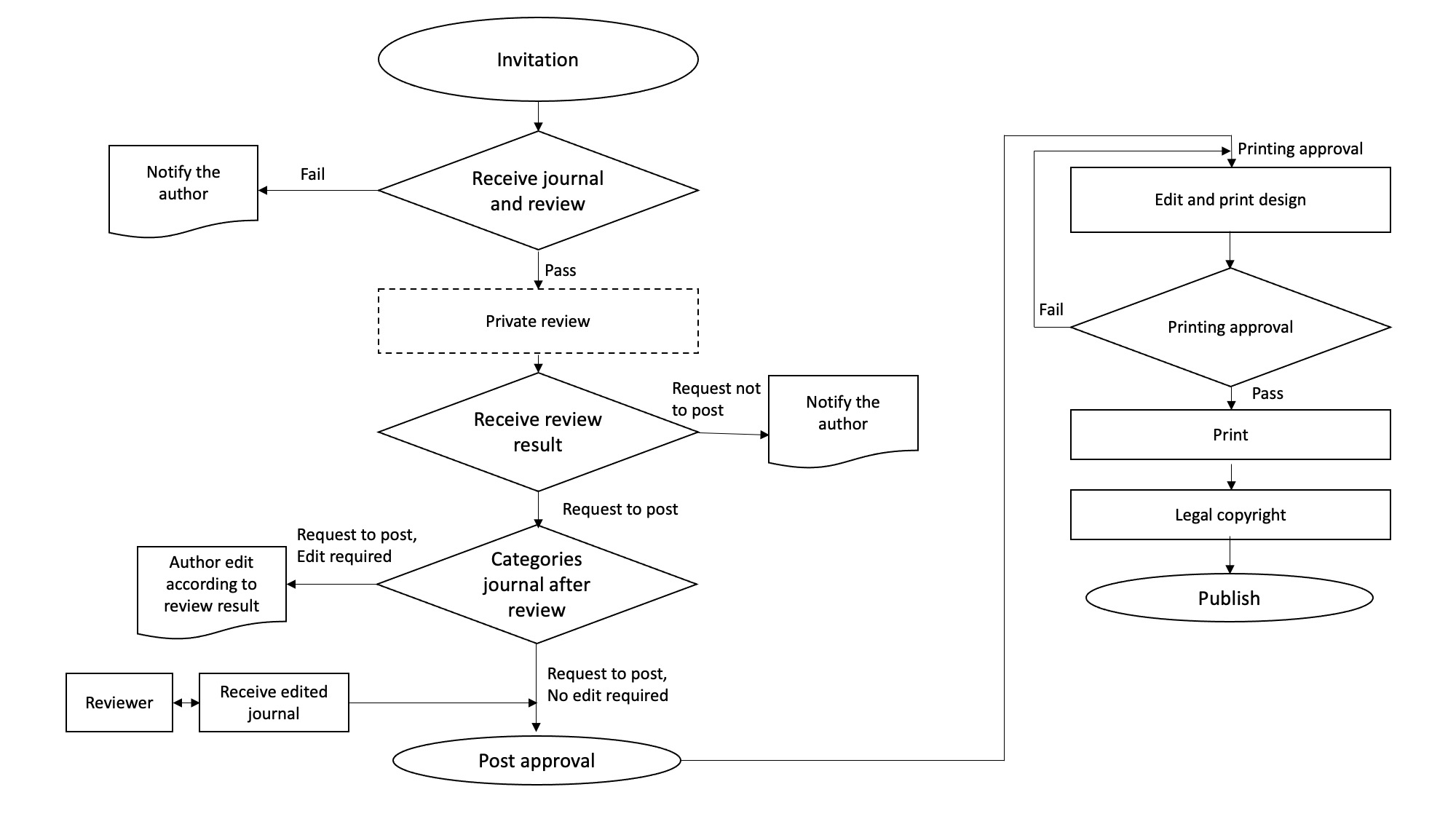
Overall, the Journal's submission approval process will be based on the following key criteria (but not limited to):
-The relevance of the article's content with the Journal's principles, purposes, and fields;
– Newness, urgency;
– Contribution to the academic field (theory, practice, research methods);
– Contribute to practice;
– Normative article composition and presentation techniques (have been requested in the article regulations).
The satisfactory articles will be submitted to the Editorial Board for approval for publication on the nearest issue.
EDITORIAL BOARD
To: Scientists, researchers, officials, lecturers, managers of research institutes, universities, and colleges.
Hong Bang International University would like to send our best wishes to you scientists, staff, and lecturers from research institutes, universities, and colleges. Hong Bang International University Science Journal.
According to the publishing license No. 2317 / GP-BTTTT dated December 27, 2011, of the Ministry of Information and Communications and the ISSN: 2615 – 9686 issued by the Ministry of Science and Technology, University Science Journal Hong Bang International publishes research works in the fields of health sciences, social sciences, and humanities, science, and technology, economic management, fine arts, construction, architecture … in language Viet has never been published in other publications.
Now, the Editorial Board of Science Magazine would like to invite researchers, managers, staff, and lecturers of research institutes, universities, and colleges to participate in writing and publishing scientific articles by Vietnamese and English on the University's Science Journal, specifically as follows:
– Fields of publication: all fields.
– Language of presentation: Vietnamese, English.
The Journal of Science of Hong Bang International University will periodically publish 4 issues in Vietnamese and 2 issues in English each year. The Editorial Board of the Journal receives the article regularly.
For further information to receive articles, please contact:
JOURNAL OF SCIENCE – HONG BANG INTERNATIONAL UNIVERSITY
Address: 215 Dien Bien Phu street, ward 15, Binh Thanh District, HCMC.
Tel: (028) 7308 3456 – Ext: 3617
Hotline: 0912 620 178
Email: journal@hiu.vn
Website: https://hiu.vn/tap-chi-khoa-hoc/
Best regards
Editorial Board
JOURNAL OF SCIENCE No.14 – Jan 2021
|
1. Nghiên cứu và phát triển mô hình Thương mại điện tử người dùng đến người dùng có kiến trúc phân tán Study of decentralized customer-to-customer e-commerce model Tác giả: Trần Mạnh Hà*, Trần Trung Dũng |
|
|
2. Tác động sự đa dạng giới tính Hội đồng quản trị đến chính sách chi trả cổ tức: Bằng chứng nghiên cứu thực nghiệm các công ty niêm yết ở Việt Nam The impact of gender diversity of board of management on dividend payment policy: The empirical evidence from listed companies in Vietnam Tác giả: Nguyễn Minh Kiều*, Lý Trúc Trinh |
|
|
3. Giải pháp giữ khách hàng sử dụng dịch vụ Internet cáp quang của VNPT Thành phố Hồ Chí Minh: Thông qua kỹ thuật APT và HVM Customer retention strategies using optical cable Internet services of VNPT Ho Chi Minh city: Through application of APT and HVM Tác giả: Nguyễn Ngọc Duy Phương*, Nguyễn Thị Thúy Mai |
|
|
4. Đo lường chỉ số SIPAS 2018 tại Ủy ban Nhân dân huyện Bàu Bàng, tỉnh Bình Dương Sipas indicator measurement at the people's committee of Bau Bang district, Binh Duong province Tác giả: Hoàng Mạnh Dũng*, Nguyễn Thị Thanh Loan |
|
|
5. Chất lượng dịch vụ và hành vi khách hàng: Trường hợp MyTV của VNPT tỉnh Tiền Giang Service quality and customer behavior: The case study of MyTV of VNPT in Tien Giang province Tác giả: Cao Minh Trí*, Lê Thị Thanh Kiều |
|
|
6. Mô hình hệ thống quản lý KPIs dựa trên năng lực then chốt của giảng viên đại học Việt Nam định hướng giáo dục 4.0 Framework for key performance management system of Vietnamese University lecturers based on core competencies in the educational era 4.0 Tác giả: Trương Hồng Chuyên*, Đặng Thanh Tuấn, Nguyễn Thị Thanh Thảo, Trần Thị Nhinh |
|
|
7. Mối quan hệ giữa đồng sáng tạo trải nghiệm du lịch và sự trung thành của khách du lịch: Nghiên cứu tại Đồng bằng sông Cửu Long – Việt Nam The relationship between co-creation tourism experience and the loyalty of tourists: Research in the Mekong Delta-Viet Nam Tác giả: Hà Thị Thùy Dương*, Lê Thị Thanh Tuyền |
|
|
8. Ảnh hưởng của chất lượng dịch vụ chữa bệnh bảo hiểm y tế đến sự hài lòng của người bệnh tại Trung tâm Y tế thành phố Ngã Bảy Impact of quality of medicine treatment service on satisfaction of patients at Nga Bay city medical center Tác giả: Nguyễn Văn Định*, Vũ Thị Thanh Duyên, Cao Thị Sen, Nguyễn Tri Khiêm |
|
|
9. Các yếu tố ảnh hưởng đến sự tiếp cận tín dụng của hộ gia đình ở nông thôn Việt Nam The determinants of rural credit in Vietnam Tác giả: Võ Thị Ngọc Trinh* |
Trong trường hợp quý độc giả muốn nhận bản Full paper, vui lòng liên hệ Ban Biên tập Tạp chí Khoa học – Trường Đại học Quốc tế Hồng Bàng.
JOURNAL OF SCIENCE No.15 – Feb 2021
|
1. Các yếu tố ảnh hưởng đến động lực làm việc của người lao động tại Bảo hiểm xã hội tỉnh An Giang Factors affecting the working motivation of Social Insurance's employee at An Giang province Tác giả: Hoàng Mạnh Dũng*, Bùi Hồng Tràng |
|
|
2. Ảnh hưởng của nền kinh tế ngầm đến lãi suất vay nợ của Chính phủ tại các quốc gia châu Á The Impact of shadow economy on the interest rate on Government debt: Evidence from Asian countries Tác giả: Nguyễn Thị Ánh Như*, Lương Thị Thúy Hường |
|
|
3. Các nhân tố ảnh hưởng đến động lực làm việc của nhân viên tại Trường Đại học Ngân hàng Thành phố Hồ Chí Minh The factors affecting employees' motivation at Banking University of Ho Chi Minh city Tác giả: Đào Lê Kiều Oanh*, Dương Thị Kim Anh |
|
|
4. Xếp hạng các công cụ sản xuất tinh gọn: Trường hợp ngành sản xuất thép tại Việt Nam Ranking the lean production tools: The case of steel industry in Vietnam Tác giả: Nguyễn Văn Đại*, Nguyễn Lê Hoàng Thụy Tố Quyên |
|
|
5. Vốn xã hội của người nông dân Khmer: Trường hợp nghiên cứu hợp tác xã nông nghiệp Evergrowth, tỉnh Sóc Trăng Social capital of Khmer farmers: A case study of Evergrowth agricultural cooperative in Soc Trang province Tác giả: Nguyễn Thị Tuyết Nương*, Châu Ngọc Thảo Nguyên, Quan Minh Quốc Bình |
|
|
6. Tác động của trách nhiệm xã hội doanh nghiệp đến ý định theo đuổi công việc: Nghiên cứu tại Thành phố Hồ Chí Minh Influence of corporate social responsibility in job pursuit intention: Evidence from Ho Chi Minh city Tác giả: Lê Đình Nghi*, Nguyễn Thị Thanh Tâm, Từ Minh Khai, Trần Nguyên An, Trần Ngọc Thanh Thảo |
|
|
7. Các nhân tố ảnh hưởng đến hiệu quả hoạt động của các quỹ tín dụng nhân dân trên địa bàn tỉnh Bình Định Factors affecting the performance of people’s creditfunds in Binh Dinh province Tác giả: Đào Lê Kiều Oanh*, Nguyễn Tấn Định |
|
|
8. Nghiên cứu thực trạng kiểm soát chất lượng chăn nuôi heo thịt theo VietGAPH tại huyện Dương Minh Châu, tỉnh Tây Ninh Study on quality control for the pig husbandry in accordance with vietGAPH at Duong Minh Chau district, Tay Ninh province Tác giả: Hoàng Mạnh Dũng1*, Dương Quốc Hoàng |
|
|
9. Giải quyết nợ xấu của các tổ chức tín dụng tại Công ty Quản lý tài sản Dealing with bad debt of credit institutions at Vietnam asset management company Tác giả: Mai Thị Trúc Ngân* |
Trong trường hợp quý độc giả muốn nhận bản Full paper, vui lòng liên hệ Ban Biên tập Tạp chí Khoa học – Trường Đại học Quốc tế Hồng Bàng.
JOURNAL OF SCIENCE No.12 – July 2020
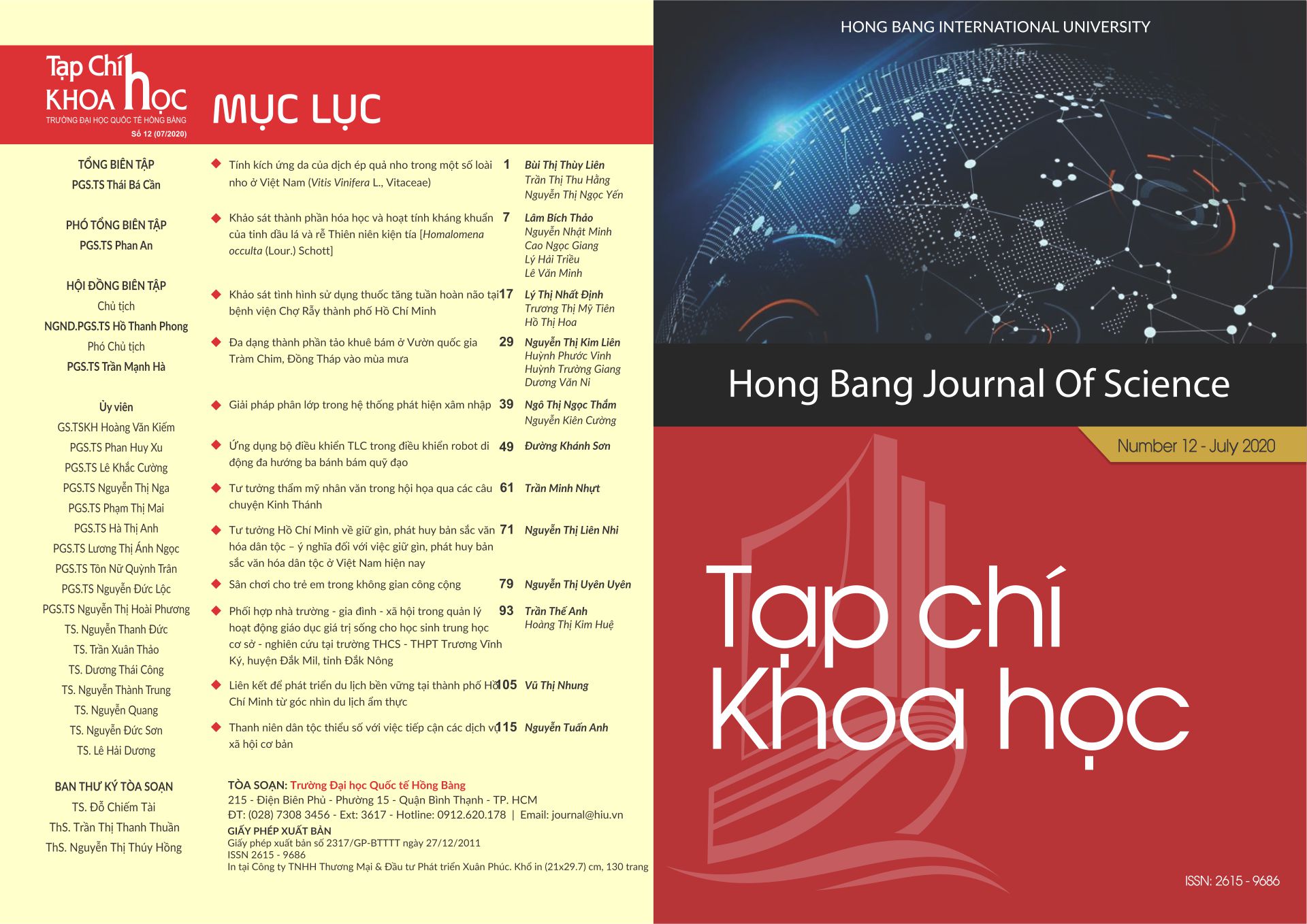
|
1. Tính kích ứng da của dịch ép quả nho trong một số loài nho ở Việt Nam (Vitis Vinifera L., Vitaceae) Skin irritation of grape juice from different types of grape in Viet Nam (Vitis vinifera l., Vitaceae) Tác giả: Bùi Thị Thùy Liên*, Trần Thị Thu Hằng, Nguyễn Thị Ngọc Yến |
|
|
2. Khảo sát thành phần hóa học và hoạt tính kháng khuẩn của tinh dầu lá và rễ thiên niên kiện tía [Homalomena Occulta (Lour.) Schott] A study on phytochemical and antibacterial activity of essential oil extracted from leaves and rhizomes of [Homalomena occulta (Lour.) Schott] Tác giả: Lâm Bích Thảo, Nguyễn Nhật Minh, Cao Ngọc Giang, Lý Hải Triều, Lê Văn Minh* |
|
|
3. Khảo sát tình hình sử dụng thuốc tăng tuần hoàn não tại bệnh viện Chợ Rẫy thành phố HỒ CHÍ MINH Examining the situation of drug use in the treatment of cerebrovascular disease at Cho Ray Hospital in HO CHI MINH city Tác giả: Lý Thị Nhất Định*, Trương Thị Mỹ Tiên, Hồ Thị Hoa |
|
|
4. Đa dạng thành phần tảo khuê bám ở vườn quốc gia Tràm Chim, Đồng Tháp vào mùa mưa Diversity of benthic diatom composition in Tram Chim National Park of Dong Thap province in the rainy season Tác giả: Nguyễn Thị Kim Liên*, Huỳnh Phước Vinh, Huỳnh Trường Giang, Dương Văn Ni |
|
|
5. Giải pháp phân lớp trong hệ thống phát hiện xâm nhập Classification solutions in intrusion detection system Tác giả: Ngô Thị Ngọc Thắm*, Nguyễn Kiên Cường |
|
|
6. Ứng dụng bộ điều khiển TLC trong điều khiển robot di động đa hướng ba bánh bám quỹ đạo Trajectory tracking control for three-wheeled omnidirectional mobile robot using TLC Tác giả: Đường Khánh Sơn |
|
|
7. Tư tưởng thẩm mỹ nhân văn trong hội họa qua các câu chuyện Kinh Thánh The Humanistic-Aesthetic conception in art through the Bible stories Tác giả: Trần Minh Nhựt |
|
|
8. Tư tưởng HỒ CHÍ MINH về giữ gìn, phát huy bản sắc văn hóa dân tộc – ý nghĩa đối với việc giữ gìn, phát huy bản sắc văn hóa dân tộc ở Việt Nam hiện nay HO CHI MINH thoughts on preserving and promoting the national and cultural identity and their meaning in Vietnam nowadays Tác giả: Nguyễn Thị Liên Nhi |
|
|
9. Sân chơi cho trẻ em trong không gian công cộng Playground in public space for children Tác giả: Nguyễn Thị Uyên Uyên |
|
|
10. Phối hợp nhà trường – gia đình – xã hội trong quản lý hoạt động giáo dục giá trị sống cho học sinh trung học cơ sở – nghiên cứu tại Trường THCS – THPT Trương Vĩnh Ký, huyện Đắk Mil, tỉnh Đắk Nông School – family – community partnerships in management of living values activities for secondary students – research at Truong Vinh Ky High School, Dak Mil district, Dak Nong province Tác giả: Trần Thế Anh*, Hoàng Thị Kim Huệ |
|
|
11. Liên kết để phát triển du lịch bền vững tại thành phố HỒ CHÍ MINH từ góc nhìn du lịch ẩm thực Co-operation for sustainable tourism development in HO CHI MINH city – views from food tourism Tác giả: Vũ Thị Nhung |
|
|
12. Thanh niên dân tộc thiểu số với việc tiếp cận các dịch vụ xã hội cơ bản Young people of ethnic minority approaching basic social services Tác giả: Nguyễn Tuấn Anh |
Trong trường hợp quý độc giả muốn nhận bản Full paper, vui lòng liên hệ Ban Biên tập Tạp chí Khoa học – Trường Đại học Quốc tế Hồng Bàng.
JOURNAL OF SCIENCE No.13 – Dec 2020
|
1. Ứng dụng chỉ thị phân tử SSR trong đánh giá độ thuần mướp hương (Luffa cylindrica L.) Application on of SSR markers for evaluating the purity of Luffa cylindrica L. lines Tác giả: Nguyễn Thị Kim Thoa, Nguyễn Thanh Tài, Huỳnh Nguyễn Minh Nghĩa, Dương Hoa Xô, Nguyễn Xuân Dũng* |
|
|
2. Giá trị dinh dưỡng của rau sứng (Strophioblachia fimbricalyx Boerl.) thu hái ở Cù Lao Chàm, Hội An, Quảng Nam The nutritional value of Strophioblachia fimbricalyx Boerl. collected from Cham island, Hoi An, Quang Nam Tác giả: Đặng Ngọc Phúc*, Nguyễn Nhân Đức, Nguyễn Lương Định |
|
|
3. Ảnh hưởng của sucrose và môi trường khoáng lên sự tạo mô sẹo và tái sinh chồi cây Ngà voi (Sansevieria cylindrica Bojer ex Hook) Effects of sucrose and mineral medium on callus induction and shoot regeneration of Sansevieria cylindrica Bojer ex Hook Tác giả: Nguyễn Văn Long, Nguyễn Thị Dương, Nguyễn Xuân Dũng* |
|
|
4. Sự thay đổi giá trị của một số xét nghiệm hóa sinh trong huyết tương được chống đông bằng Natri florua theo thời gian và nhiệt độ bảo quản Changes in some biochemical analytes in fluorinated plasma over storage time and temperature Tác giả: Vũ Hồng Hải*, Lê Phan Vi Na, Nguyễn Ngọc Minh Thư, Nguyễn Thị Bảo Minh, Thân Thị Tuyết Trinh |
|
|
5. Kinh nghiệm ứng phó bùng phát dịch Covid-19: Bài học từ Việt Nam (nghiên cứu dữ liệu từ ngày 24/12/2019 đến ngày 10/05/2020) Facing Covid-19 outbreak experience: lesson from Vietnam (research data from 24th Dec 2019 to 10th May 2020) Tác giả: Võ Minh Hiếu |
|
|
6. Ứng dụng lý thuyết cơ học chất lỏng để thiết kế đĩa khuôn của máy ép đùn tạo hình thức ăn thủy sản Application of fluid mechanics principles for die plates designing of aqua-feed extruders Tác giả: Lê Đức Trung |
|
|
7. Bộ điều khiển pid online auto – tuning sử dụng mạng nơ ron cho hệ xe hai bánh tự cân bằng Online auto-tuning pid controller using neural network for two-wheeled self-balancing robot Tác giả: Hoàng Anh Vũ*, Đào Tăng Tín |
|
|
8. Ứng dụng công nghệ thông tin xây dựng hệ thống phần mềm hỗ trợ công tác chuẩn bị bay huấn luyện cho Trung đoàn không quân phía Nam Application of information technologies in building system software to support preparing for flight training for the Air Force Regiment in Southern Vietnam Tác giả: Nguyễn Khắc Điệp*, Trần Trọng Việt, Nguyễn Văn Sơn |
|
|
9. Đánh giá hiệu suất của các thuật toán học máy để phát hiện địa chấn Tran Thanh Cong*, Dao Tang Tin Tác giả: Trần Thành Công*, Đào Tăng Tín |
|
|
10. Xây dựng các nhóm đồ án kiến trúc theo hướng phát triển bền vững trong chương trình đào tạo Construct the groups of architectural projects under sustainable development way in curriculum Tác giả: Phạm Đăng Tuấn Lâm |
|
|
11. Mô hình dạy học trực tuyến ở đại học – những khó khăn và giải pháp khắc phục Evaluating the disadvantages of internet-based learning at university level and effective solutions Tác giả: Nguyễn Văn Thứ*, Bùi Thị Minh Nguyệt, Phạm Thanh Sơn |
|
|
12. Từ Hán Hàn – Hán Việt đồng âm khác nghĩa và các phương pháp giảng dạy từ Hán Hàn đồng âm khác nghĩa cho sinh viên Việt Nam An experimental study of adapting project – based learning in English speaking skills teaching at HIU Tác giả: Mai Như Nguyệt |
|
|
13. Thực nghiệm phương pháp học theo dự án trong lớp học nói tiếng Anh ở Đại học Quốc tế Hồng Bàng An experimental study of adapting project – based learning in English Speaking skills teaching at HIU Tác giả: Nguyễn Như Tùng*, Tiêu Bích San, Nguyễn Thị Bích Thảo |
|
|
14. Thực trạng và giải pháp xuất khẩu nông sản vùng đồng bằng sông Cửu Long Current situation and feasible solutions for Mekong Delta's agricultural exports Tác giả: Huỳnh Thanh Nhã, Nguyễn Thị Thu An, Nguyễn Thị Ngọc Anh* |
Trong trường hợp quý độc giả muốn nhận bản Full paper, vui lòng liên hệ Ban Biên tập Tạp chí Khoa học – Trường Đại học Quốc tế Hồng Bàng.
JOURNAL OF SCIENCE No.10 – Dec 2019
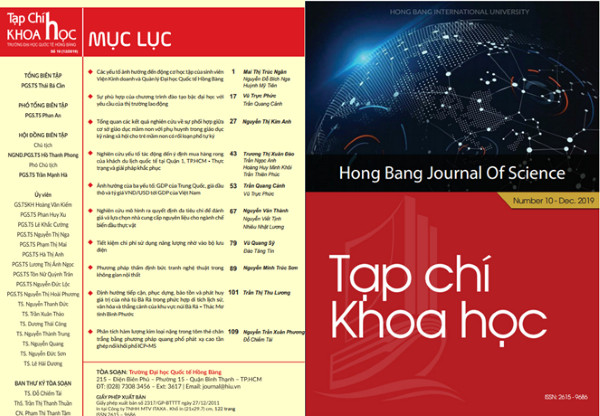
|
1. Các yếu tố ảnh hưởng đến động cơ học tập của sinh viên Viện Kinh doanh và Quản lý Đại học Quốc tế Hồng Bàng The factors affecting students’ motivation to learn at School of Business and Management in Hong Bang International University Tác giả: Mai Thị Trúc Ngân, Nguyễn Đỗ Bích Nga, Huỳnh Mỹ Tiên |
Abstract Full paper |
|
2. Sự phù hợp của chương trình đào tạo bậc đại học với yêu cầu của thị trường lao động The suitability of a school curriculum at a university level for the requirements of the labor market Tác giả: Vũ Trực Phức, Trần Quang Cảnh |
Abstract Full paper |
|
3. Tổng quan các kết quả nghiên cứu về sự phối hợp giữa cơ sở giáo dục mầm non với phụ huynh trong giáo dục kỹ năng xã hội cho trẻ mầm non có rối loạn phổ tự kỷ An overview of research results related to collaboration between kindergartens with parents in social skills education for preschool children with autism spectrum disorder Tác giả: Nguyễn Thị Kim Anh |
Abstract Full paper |
|
4. Nghiên cứu yếu tố tác động đến ý định mua hàng rong của khách du lịch quốc tế tại Quận 1, TP.HCM – thực trạng và giải pháp khắc phục Factors affecting international tourists’ behavioral intention in buying street vendors when traveling at District 1, Ho Chi Minh city – the situation and solutions Tác giả: Trương Thị Xuân Đào, Trần Ngọc Anh, Hoàng Huy Minh Khôi, Trần Thiên Phúc |
Abstract Full paper |
|
5. Ảnh hưởng của ba yếu tố: GDP của Trung Quốc, giá dầu thô và tỷ giá VND/USD tới GDP của Việt Nam The effects of three factors: China’s GDP, crude oil price, VND/USD exchange rate to the GDP of Vietnam Tác giả: Trần Quang Cảnh, Vũ Trực Phức |
Abstract Full paper |
|
6. Nghiên cứu mô hình ra quyết định đa tiêu chí để đánh giá và lựa chọn nhà cung cấp nguyên liệu cho ngành chế biến dầu thực vật The study of multicriteria decision making model (MCDM) for supplier evaluation and selection in the vegetable oil industry Tác giả: Nguyễn Văn Thành, Nguyễn Viết Tịnh, Nhiêu Nhật Lương |
Abstract Full paper |
|
7. Tiết kiệm chi phí sử dụng năng lượng nhờ vào bộ lưu điện The cost savings of energy based on the uninter-ruptible power supply Tác giả: Vũ Quang Sỹ, Đào Tăng Tín |
Abstract Full paper |
|
8. Phương pháp thẩm định bức tranh nghệ thuật trong không gian nội thất Method of appraising art paintings in the interior space Tác giả: Nguyễn Minh Trúc Sơn |
Abstract Full paper |
|
9. Định hướng tiếp cận, phục dựng, bảo tồn và phát huy giá trị của nhà tù Bà Rá trong phức hợp di tích lịch sử, văn hóa và thắng cảnh của khu vực núi Bà Rá – Thác Mơ tỉnh Bình Phước Orient directions to approach, restore, preserve and exploit the values of Ba Ra prison in the complex of historical – cultural relics and the scenic beauty of ba ra mountainous area – Mo Waterfall in Binh Phuoc province Tác giả: Trần Thị Thu Lương |
Abstract Full paper |
|
10. Phân tích hàm lượng kim loại nặng trong tôm thẻ chân trắng bằng phương pháp quang phổ phát xạ cao tần ghép nối khối phổ ICP-MS Determination of heavy metals in litopenaeus vannamei by inductively coupled plasma mass spectrometry Tác giả: Nguyễn Trần Xuân Phương, Đỗ Chiếm Tài |
Abstract Full paper |
Trong trường hợp quý độc giả muốn nhận bản Full paper, vui lòng liên hệ Ban Biên tập Tạp chí Khoa học – Trường Đại học Quốc tế Hồng Bàng.
JOURNAL OF SCIENCE No.11 – March 2020
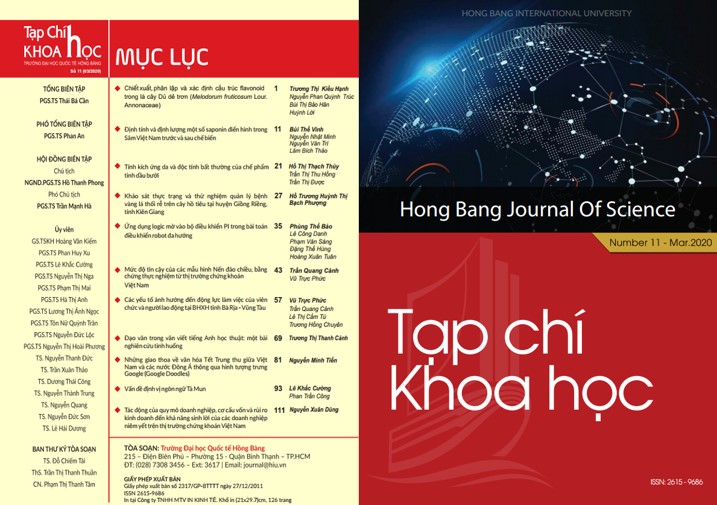
|
1. Chiết xuất, phân lập và xác định cấu trúc flavonoid trong lá cây Dủ dẻ trơn (Melodorum fruticosum Lour. Annonaceae) Extraction, isolation and identification of flavonoid from Melodorum fruticosum leaves Tác giả: Trương Thị Kiều Hạnh, Nguyễn Phan Quỳnh Trúc, Bùi Thị Bảo Hân, Huỳnh Lời |
|
|
2. Định tính và định lượng một số saponin điển hình trong Sâm Việt Nam trước và sau chế biến Qualitative and quantitative determination of typical saponins in panax Vietnamensis and processed panax Vietnamensis Tác giả: Bùi Thế Vinh, Nguyễn Nhật Minh, Nguyễn Văn Trí, Lâm Bích Thảo |
|
|
3. Tính kích ứng da và độc tính bất thường của chế phẩm tinh dầu bưởi Skin irritation and abnormal toxicity of essential oil extracted from citrus maxima merr. peels Tác giả: Hồ Thị Thạch Thúy, Trần Thị Thu Hồng, Trần Thị Được |
|
|
4. Khảo sát thực trạng và thử nghiệm quản lý bệnh vàng lá thối rễ trên cây hồ tiêu tại huyện Giồng Riềng, tỉnh Kiên Giang Examining the situation and studying the control of the root wilt disease of black pepper in Giong Rieng district, Kien Giang province Tác giả: Hồ Trương Huỳnh Thị Bạch Phượng |
|
|
5. Ứng dụng logic mờ vào bộ điều khiển PI trong bài toán điều khiển robot đa hướng Applying fuzzy logic to PI controller for the problem of omnidirectional robot control Tác giả: Phùng Thế Bảo, Lê Công Danh, Phạm Văn Sáng, Đặng Thế Hùng, Hoàng Xuân Tuân |
|
|
6. Mức độ tin cậy của các mẫu hình Nến đảo chiều, bằng chứng thực nghiệm từ thị trường chứng khoán Việt Nam The reliability of Candlestick reverse patterns, empirical evidence from the Vietnam stock market Tác giả: Trần Quang Cảnh, Vũ Trực Phức |
|
|
7. Các yếu tố ảnh hưởng đến động lực làm việc của viên chức và người lao động tại BHXH tỉnh Bà Rịa – Vũng Tàu Factors affecting officials and employees motivation at the Social Insurance in Ba Ria – Vung Tau province Tác giả: Vũ Trực Phức, Trần Quang Cảnh, Lê Thị Cẩm Tú, Trương Hồng Chuyên |
|
|
8. Đạo văn trong văn viết tiếng Anh học thuật: một bài nghiên cứu tình huống Understanding plagiarism in academic writing context: a case study Tác giả: Trương Thị Thanh Cảnh |
|
|
9. Những giao thoa về văn hóa Tết Trung thu giữa Việt Nam và các nước Đông Á thông qua hình tượng trưng Google (Google Doodles) The cross-cultural dimensions of Mid-Autumn Festival between Vietnam and East Asian countries through the studying of Google Doodles Tác giả: Nguyễn Minh Tiến |
|
|
10. Vấn đề định vị ngôn ngữ Tà Mun Determination the position of Ta Mun language Tác giả: Lê Khắc Cường, Phan Trần Công |
|
|
11. Tác động của quy mô doanh nghiệp, cơ cấu vốn và rủi ro kinh doanh đến khả năng sinh lời của các doanh nghiệp niêm yết trên thị trường Chứng khoán Việt Nam The impact of firm size, capital structure and business risks on profitability of businesses listed on Vietnam's stock market Tác giả: Nguyễn Xuân Dũng |
Trong trường hợp quý độc giả muốn nhận bản Full paper, vui lòng liên hệ Ban Biên tập Tạp chí Khoa học – Trường Đại học Quốc tế Hồng Bàng.
JOURNAL OF SCIENCE No.8 – July 2019

|
1. Phân tích, đánh giá hàm lượng một số kim loại trong thịt cá diêu hồng (oreochromis.spp) nuôi ở khu vực phường Bắc Nghĩa, thành phố Đồng Hới, tỉnh Quảng Bình Analysis and evaluation of the metal contents in red tilapia (oreochromis. Spp) cultured at Bac Nghia ward, Dong Hoi city, Quang Binh province Tác giả: Nguyễn Mậu Thành |
Abstract Full paper |
|
2. Nghiên cứu sản xuất giống cá bông lau (Pangasius Krempfi Fang & Chaux 1949) tại Đồng Tháp Study the production of Pangasius krempfi Fang & Chaux 1949 in Dong Thap province Tác giả: Huỳnh Văn Mừng, Phạm Văn Khánh, Nguyễn Thị Nga, Ngô Văn Tuấn |
|
|
3. Tầm soát nguy cơ đái tháo đường và tiền đái tháo đường ở sinh viên Khoa Xét nghiệm Y học trường Đại học Quốc tế Hồng Bàng Screening for the risks of acquiring diabetes and pre-diabetes in students of the Faculty of Medical Laboratory Science of Hong Bang International University Tác giả: Lương Trần Thanh Duy, Phạm Thị Ái Hoàng, Đoàn Như Quỳnh, Nguyễn Văn Trung |
|
|
4. Tần số điểm đa hình rs12979860 và rs8099917 trên gene IL28B ở bệnh nhân nhiễm virus viêm gan siêu vi C rs12979860 and rs8099917 in IL28B gene of single nucleotide polymorphisms in patients with chronic hepatitis C Tác giả: Hà Thị Anh, Cao Minh Nga, Nguyễn Tuấn Anh |
|
|
5. Khảo sát tỷ lệ tăng cholesterol và triglyceride ở sinh viên Khoa Xét nghiệm Y học trường Đại học Quốc tế Hồng Bàng Investigate the rate of cholesterol and triglyceride increase in students of the Faculty of Medical Laboratory Technology of Hong Bang International University Tác giả: Nguyễn Văn Trung, Huỳnh Ngọc Phương Linh, Nguyễn Anh Duy, Nguyễn Ngọc Kim Ngân, Nguyễn Thanh Nhật |
|
|
6. Những nét tiêu biểu trong tiểu văn hóa kinh doanh phố Tây Typical features of subculture business in Westerns’ Town Tác giả: Tôn Nữ Quỳnh Trân, Trần Xuân Thắng, Trương Hoàng Trương |
|
|
7. Phát huy di sản văn hóa ở Khánh Hòa từ góc nhìn du lịch Promoting cultural heritage in Khanh Hoa from the tourism perspective Tác giả: Nguyễn Văn Bốn |
|
|
8. Vấn đề về nâng cao năng lực ngôn ngữ học xã hội cho người học tiếng Anh Issues in enhancing socio-linguistics competence for learners of English Tác giả: Phan Thị Lệ Hoa |
|
|
9. Các yếu tố ảnh hưởng đến ý định khởi sự doanh nghiệp của sinh viên Viện Kinh doanh và Quản lý Đại học Quốc tế Hồng Bàng The factors affecting of entrepreneurial intention of students at school of Business and Management in Hong Bang International University Tác giả: Nguyễn Đỗ Bích Nga, Huỳnh Mỹ Tiên |
Trong trường hợp quý độc giả muốn nhận bản Full paper, vui lòng liên hệ Ban Biên tập Tạp chí Khoa học – Trường Đại học Quốc tế Hồng Bàng.
JOURNAL OF SCIENCE No.9 – Sep 2019
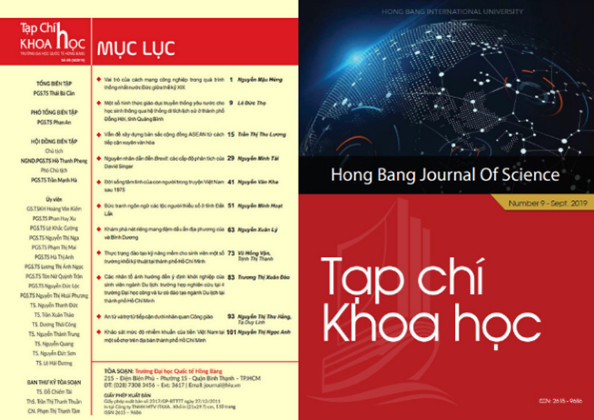
|
1. Vai trò của cách mạng công nghiệp trong quá trình thống nhất nước Đức giữa thế kỷ XIX The role of the industrial revolution in the mid-nineteenth-century German unification Tác giả: Nguyễn Mậu Hùng |
Abstract Full paper |
|
2. Một số hình thức giáo dục truyền thống yêu nước cho học sinh thông qua hệ thống di tích lịch sử ở thành phố Đồng Hới, tỉnh Quảng Bình Some traditional forms patriotic education for students through the historical relics system in Dong Hoi city, Quang Binh province Tác giả: Lê Đức Thọ |
Abstract Full paper |
|
3. Vấn đề xây dựng bản sắc cộng đồng ASEAN từ cách tiếp cận xuyên văn hóa Building ASEAN community identity from the trans-culture approach and lessons for the development of Vietnamese modern culture Tác giả: Trần Thị Thu Lương |
Abstract Full paper |
|
4. Nguyên nhân dẫn đến Brexit: các cấp độ phân tích của David Singer Causes of Brexit: levels of analysis by David Singer Tác giả: Nguyễn Minh Tài |
Abstract Full paper |
|
5. Đời sống tâm linh của con người trong truyện Việt Nam sau 1975 Spiritual life in Vietnamese stories after the Vietnam war (1975) Tác giả: Nguyễn Văn Kha |
Abstract Full paper |
|
6. Bức tranh ngôn ngữ các tộc người thiểu số ở tỉnh Đắk Lắk An overview of the ethnic minority languages in Dak Lak province Tác giả: Nguyễn Minh Hoạt |
Abstract Full paper |
|
7. Khám phá nét riêng mang đậm dấu ấn địa phương của vè Bình Dương Discovering the distinctive features of Binh Duong’s folk poems Tác giả: Nguyễn Xuân Lý |
Abstract Full paper |
|
8. Thực trạng đào tạo kỹ năng mềm cho sinh viên một số trường khối kỹ thuật tại thành Phố Hồ Chí Minh The real situation of training soft skills for students at some engineering universities in Ho Chi Minh city Tác giả: Vũ Hồng Vận, Trịnh Thị Thanh |
Abstract Full paper |
|
9. Các nhân tố ảnh hưởng đến ý định khởi nghiệp của sinh viên ngành du lịch: trường hợp nghiên cứu tại 4 trường đại học công và tư có đào tạo ngành du lịch tại thành phố Hồ Chí Minh Factors affecting the the start-up business of students in tourism at universities in Ho Chi Minh city Tác giả: Trương Thị Xuân Đào |
Abstract Full paper |
|
10. An tử và trợ tử tiếp cận dưới nhãn quan Công giáo Euthanasia and assisted suicide approached under Catholicism’s vision Tác giả: Nguyễn Thị Thu Hằng, Tạ Duy Linh |
Abstract Full paper |
|
11. Khảo sát mức độ nhiễm khuẩn của tiền Việt Nam tại một số chợ trên địa bàn thành phố Hồ Chí Minh Investigating the level of microbial contamination of Vietnamese currency notes at some markets in Ho Chi Minh city Tác giả: Nguyễn Thị Ngọc Anh |
Abstract Full paper |
Trong trường hợp quý độc giả muốn nhận bản Full paper, vui lòng liên hệ Ban Biên tập Tạp chí Khoa học – Trường Đại học Quốc tế Hồng Bàng.
JOURNAL OF SCIENCE (English version) No.1 – Dec 2020
|
1. Strategies for controlling viral diseases of orchids in Vietnam Chiến lược kiểm soát bệnh virus hoa lan ở Việt Nam Author: Nguyen Xuan Dung*, Nguyen Thi Thanh Thao, Duong Hoa Xo |
|
|
2. Chemical constituents and pharmacological effects from different parts of grape Vitis vinifera L. (Vitaceae): A review Tổng quan về thành phần hóa học và tác dụng dược lý của các bộ phận của cây nho Vi s vinifera L. (vitaceae) Author: Ly Hong Huong Ha*, Tran Trung Trinh, Vo Thi Bich Ngoc |
|
|
3. Calculation the thermodynamic properties of carbon monoxide gas using monte Carlo simulation for adsorption researches Tính toán các tinh chất nhiệt động của khí CO bằng mô phỏng Monte Carlo cho các nghiên cứu về hấp phụ Author: Nguyen Thanh Duoc* |
|
|
4. Digitalize agriculture in Vietnam, opportunities, and challenges Số hóa nông nghiệp Việt Nam, cơ hội và thách thức Author: Nguyen Quoc Khanh*, Huynh Thi Thu Cuc |
|
|
5. On the densest packing of equal spheres into a three-dimensional convex set Phương pháp giải bài toán sắp xếp các khối cầu giống nhau vào tập lồi trong không gian ba chiều Author: Nguyen Huy Liem*, Phung The Bao, Ta Trung Thanh, Vuong Anh Tuan, Pham Thi Tuyet |
|
|
6. Credit card fraud detection based on machine learning Phát hiện gian lận thẻ tín dụng dựa trên học máy Author: Tran Thanh Cong*, Le Pham Tuan Kiet |
|
|
7. Reading comprehension difficulties among EFL learners: the case of English-majored students at Bac Lieu university Khó khăn trong việc đọc hiểu tiếng Anh của người học tếng Anh như một ngoại ngữ: Trường hợp của sinh viên chuyên Anh Trường Đại học Bạc Liêu Author: Nguyen Truc An* |
|
|
8. A contrastive analysis of semantic features of the verb “cut” in English collocations and their equivalents in Vietnamese Phân tích đối chiếu các đặc điểm ngữ nghĩa của động từ “cut” trong các ngữ cố định tếng Anh và các cụm từ tương đương trong tiếng Việt Author: Ta Thi Kim Oanh* |
|
|
9. Metaphoric meanings of words denoting animals in English and Vietnamese Nghĩa ẩn dụ của từ chỉ động vật tiếng Anh và tiếng Việt Author: Huynh Thi Ut* |
|
|
10. A review of studies on teachers’ written corrective feedback Báo cáo tổng hợp từ các nghiên cứu về nhận xét của giáo viên cho bài viết học sinh Author: Do Manh Hieu*, Phan Le Thu Huong |
|
|
11. The effectiveness of internship practice for English language majors Nâng cao hiệu quả thực tập chuyên môn trong chương trình đào tạo Cử nhân Ngôn ngữ Anh Author: Doan Thi Hue Dung*, Nguyen Nhu Tung, Pham Khac Thoi |
|
|
12. Social Relationships & Language Discourse: The Influence of Friendship & Personality on Meaning Negotiation among International Students Quan hệ xã hội và diễn ngôn: Sự ảnh hưởng của tình bạn và tính cách trong điều chỉnh nghĩa lời nói giữa các sinh viên quốc tế Author: Nguyen Thi Dan Tam* |
Trong trường hợp quý độc giả muốn nhận bản Full paper, vui lòng liên hệ Ban Biên tập Tạp chí Khoa học – Trường Đại học Quốc tế Hồng Bàng.
Look up the journal name in the ISI directory
The ISI directory includes prestigious scientific journals around the world. Currently, the ISI list has been used by most science and technology organizations (research institutes, universities) as the main reference source to evaluate and rate the science and technology research capacity of an institute, a university. a country, an individual scientist, or a graduate student. This article describes how to look up journal names in the ISI directory.
What is ISI?
ISI stands for Institute for Scientific Information. The institute was founded in 1960 by Eugene Garfield, which was later acquired by Thomson Scientific and is now known as Thomson Scientific, a commercial division of Reuters Corporation. This is a rich database with more than 10,000 journals objectively selected and processed by experts to categorize according to fields, including natural sciences with more than 7,100 journals from 1900 to Now, social science with more than 2,100 journals since 1956, arts and humanities with more than 1,200 journals since 1975.
ISI has placed the prestigious journals of the natural sciences into two lists: SCI (Scientific Citation Index) and SCIE (Scientific Citation Index Expanded). Each journal has an impact index (Impact Factor – IF) calculated based on the number of citations to its articles. In fact, there are not only journals in English on the ISI list but also journals in other languages, though not many. In the list of tens of thousands of SCI and SCIE journals, in addition to the journals published in the US, the UK also has quite a few journals published in different countries and regions in the world.
ISI's assessment and statistics criteria are used by most science and technology organizations (research institutes, universities) as the main reference source to evaluate and rate the science and technology research capacity of an institute, a university. university or country. Even scientists in non-English speaking countries such as Russia, France, Germany, etc. also accept these criteria.
Look up the names of journals in the ISI directory
To look up journals in the ISI directory, go to the following website: Here or Here.
You can look up journal titles in one of the following ways:
1. Look up the full journal title: Enter the full journal title in the first input box and select “Full Journal Title” in the next selection box.
2. Lookup a word in journal-title: Enter only one word to look up in the first input box and select “Title Word” in the next selection box.
3. Lookup by ISSN code of the journal: Enter the ISSN code you want to look up in the first input box and select “ISSN” in the next selection box.
To find out that the journal you find is in the SCI or SCIE directory, click Coverage directly below the journal-title.
Research Affairs
Look up the journal name in the SCOPUS directory
Besides the ISI classification, many world ranking institutions, such as SCIMAGO (http://scimagojr.com) or the QS World University Rankings , http://www.topuniversities.com),…, also uses the database from SCOPUS source.
SCOPUS has been built in November 2004 and is owned by Elsevier Publishing House (Netherlands), for paid online subscription. It is a bibliographic database containing abstracts and citations of scientific articles. SCOPUS contains 57 million abstracts, nearly 22,000 categories from more than 5,000 publishers, of which more than 30,000 are peer-reviewed journals in Science, Engineering, Health, Society, Arts, and Humanities.
To be listed on the SCOPUS list, journals are also strictly selected. The number of journals in Scopus is almost double that of the ISI, but not all-encompassing, only about 70% of the ISI volume. However, the Scopus source includes only articles published since 1995. The way to evaluate the quality of SCOPUS journals is also based on the IF (Impact factor) or JIF (Journal Impact Factor) index, but the website content of SCOPUS (http://www.scopus.com) is very useful. when used for many different purposes, from searching documents to assessing the situation of scientific research of individuals and training institutions, research, …
List of international journals on the SCOPUS list:
https://www.elsevier.com/solutions/scopus/content or
https://www.scopus.com/sources.uri?zone=TopNavBar&origin=searchbasic
Research Affairs
Look up the List of Scientific journals that are scored by the National Policy Council - The year 2019
July 10, 2019, Prof.Dr.Le Quang Cuong, Vice Chairman of the State Council of Professors, signed the Decision approving the list of scientific journals scored by 28 Council of professors, interdisciplinary in 2019.
Decision No. 29 / QD-HDGSNN (Download)
|
LIST OF SCIENTIFIC CREDITORS OF THE STATE BOARD OF PROFESSORS |
Attached files |
| 1. Council of Animal Husbandry – Veterinary – Fishery | |
| 2. Mechanical Industry Council | |
| 3. Mechanical Interdisciplinary Council – Motivation | |
| 4. Information Technology Council | |
| 5. Council of Pharmacology | |
| 6. Electrical – Electronic – Automation Interdisciplinary Council | |
| 7. Transportation Industry Council | |
| 8. Council for Education Studies | |
| 9. Interdisciplinary Council of Chemistry – Food Technology | |
| 10. Security Science Industry Council | |
| 11. Military Science Industry Council | |
| 12. Earth Science – Mining Interdisciplinary Council | |
| 13. Economic Council | |
| 14. Jurisprudence Council |
|
LIST OF SCIENTIFIC CREDITORS OF THE STATE BOARD OF PROFESSORS |
Attached files |
| 15. Metallurgical Industry Council | |
| 16. Council of Linguistics | |
| 17. Agriculture – Forestry Interdisciplinary Council | |
| 18. Biology Council | |
| 19. Council of Interdisciplinary History – Archeology – Ethnology | |
| 20. Psychology Council | |
| 21. Irrigation Industry Council | |
| 22. Mathematics Council | |
| 23. Interdisciplinary Council of Philosophy – Sociology – Politics | |
| 24. Interdisciplinary Council of Culture – Arts – Sports | |
| 25. Council for Literature | |
| 26. Physics Council | |
| 27. Construction – Architecture Interdisciplinary Council | |
| 28. Medical Industry Council |
References, scientific journals, reputable publishers
Reference links:
Check out the magazine's SJR (Quartile) ranking: http://www.scimagojr.com/index.php
Check out the magazine's ABS ranking: https://charteredabs.org/academic-journal-guide-2018-view/
Check out the magazine's ABDC ranking: https://abdc.edu.au/research/abdc-journal-list/
Authenticate ISSN number (ISSN number without space symbol): https://portal.issn.org/
Look up the List of prestigious journals in 2017 in the field of social sciences and humanities of NAFOSTED:
https://nafosted.gov.vn/wp-content/uploads/2017/08/qd-danh-muc-tcqt-2017-final-co-dau-1.pdf
Look up the List of prestigious journals in 2019 applicable to basic research topics in the field of natural sciences and engineering sponsored by NAFOSTED: https://nafosted.gov.vn/ban-hanh -discover-of-the-prestigious-year-2019-in-the-place-with-partners-in-spirit-science-science-the-land-and-sign-of-the-trees-to-tro/
In addition, the authors can also refer to some links below to look up the list of prestigious journals of leading publishers and famous universities in the world:
* Springer Publishing company: click here
* Elsevier Publishing company: click here
* Wiley-Blackwell Publishing company: click here
* Taylor & Francis Publishing company: click here
* Sage Publishing company: click here
* Oxford University Press: click here
* Cambridge University Press: click here
* Chicago University Press: click here
* Liverpool University Press: click here
* Emerald: ckick here
* Macmillan Publishers: click here
* Inderscience Publishers: click here
* Edward Elgar Publishing: click here
Ways to cite documents when writing scientific articles
REFERENCES UNDER IEEE STANDARDS IN WORD
Doing topics, dissertations, dissertations, and writing scientific articles requires a lot of references and quotations. Some of you still use manual citation. Meanwhile, there are many popular support tools such as Citation & Bibliography in Word's Reference. There are many default standards in the Citation & Bibliography Style. But there are two standards that cite universal references: IEEE in research for the engineering sciences and APPA for research in the social sciences.
Today, the Editorial Board of Science magazine presented how to cite IEEE standard references in Microsoft Word, mainly 2010 and above.
Step 1: In Word, you choose the References tab and choose IEEE standard in Style

Step 2: Add references
-
- First, you choose References → Manage Sources.

-
- If the document already exists on the Master List, select the document and select Copy to convert the document to the Current List.
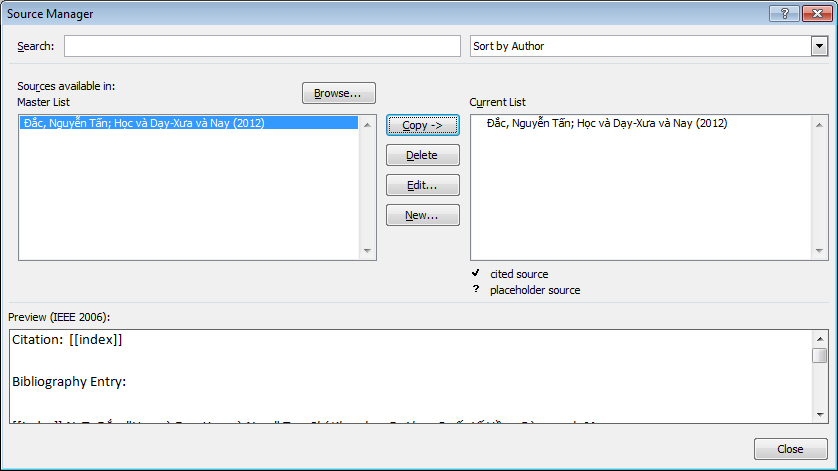
-
- If you want to add a new document, choose New in Source Manager.

-
- In Create Source you choose Type of Source (type of document source) and enter information for the author's name (Author), Title of document (Title), Year of publication (Year) … then select OK.
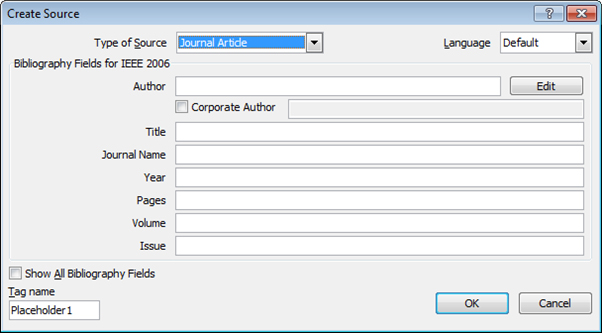
-
- If you want to add new documents, choose New and continue to add, after you have finished adding close Manage Sources.
Step 5: To cite references, click next to the text you want to cite and choose Insert Citation and select the document you want to cite. According to IEEE standards, after quoting, the results will be as follows:
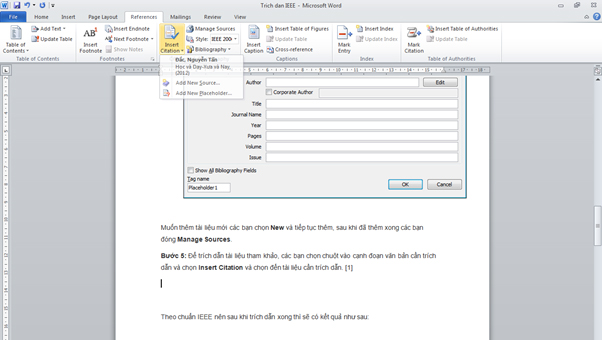
For other paragraphs to quote you do the same to add citations.
Step 6: Create a list of references. You put your mouse in the place you want to create a bibliography, then choose Bibliography and choose the type of category you want.
And the result is:

The above shows how to cite references to the IEEE standard for the engineering sciences. For the social sciences, you can quote with APPA standards and steps as well as above.
Good luck.
INSTRUCTIONS ON HOW TO EXCIT REFERENCES
AND LIST OF REFERENCES
1. References
References include documents cited, used, and mentioned in theses, theses, dissertations, articles …
Reference citation has important implications for scientific research reports (increases the value of research topics through comparison, reference, comparison, … with external sources. clearly show the source of the collected information) and to the reporter (developing research capacity: thanks to the process of searching and selecting quality information, helping to increase the likelihood of self-study and self-finding. Search for information and exploit information; foster a sense of professional ethics, avoid plagiarism …). Two of the most common citation are “author name – year" (Harvard system) and numerical (Vancouver system) are currently selected by the Ministry of Education and Training of Vietnam.
Citation sources must be recognized as soon as the information is used. A citation source can be placed at the beginning, middle, or end of a sentence, the end of a paragraph, or the end of a direct quote (for example, a drawing, a diagram, a formula, a verbatim paragraph).
2. Forms and principles of reference
2.1. Quote form
A direct quote is the verbatim quotation of part of a sentence, a sentence, a paragraph, pictures, diagrams, process, … of the original to the article. A verbatim quotation must ensure that each sentence, word, and punctuation is exactly used in the original quote. “Citations are in quotation marks", [TLTK number] is in square brackets. Do not use too many of these quotes because the article will be heavy and monotonous.
An indirect quote is to use an idea, result, or idea of an issue to describe in his own writing, but to ensure the correct content of the original. This is the recommended citation for use in scientific research. When quoting in this way, care should be taken to avoid misinterpretation, and be sure to be faithful to the content of the original article.
Secondary citation is when a writer wants to quote a piece of information through a quote in another author's document. For example, when the writer wants to quote a piece of information originating from author A, but cannot find the original source A directly, but through a document of author B. When quoting in this way, the list is not listed. cited documents of author A in the bibliography. The higher the scientific requirement of a document, the less likely it is to limit secondary citations, and to access as many originals as possible.
2.2. Some principles of reference citation
References can be cited and used in problem statements, reviews, research methods, discussions. The research hypotheses, research results, conclusions, and recommendations are not used for references.
A citation must be consistent throughout the article and consistent with the presentation in the list of references.
The citation is in the order of the references in the References list and enclosed in square brackets when the page number is required, eg [15, 314-315]. For sections cited from multiple documents, each item's number is enclosed in square brackets and in ascending order, separated by commas and without spaces, Example [19], [25], [41].
The use or citation of the research results of others or co-authors must be fully and clearly cited. If using documents of other people (quoting tables, tables, formulas, graphs, and other documents) without annotating the author and source, the thesis is not approved for protection.
Do not record academic titles, degrees, social status of the author in the information quoted.
Documents cited in the article must be in the bibliography.
Materials listed in the bibliography must have a citation in the article.
Do not quote documents that the writer has not read. Cite only when the writer must have the document in hand and have read it. It is not advisable to quote small details, personal opinions, subjective experiences, the knowledge that has become commonplace.
When a piece of information is talked about by many people, it is advisable to cite reputable research/articles/authors in the field.
3. Developing and presenting a list of references
The list of references is sorted according to the order of use (quotes) in theses, dissertations, articles … regardless of Vietnamese, English, French … References are cited according to number (identified in the bibliography), not by author name and year. Documents in foreign languages must be kept intact, not transcribed or translated. For documents written in a foreign language that few Vietnamese know, it is possible to include a Vietnamese part accompanying each document. Do not use dissertations, dissertations, websites and restrict the use of textbooks as references.
3.1. References are articles in magazines and journals are presented as follows:
Nguyen Kim Son, Pham Hung Van, Nguyen Bao Son et al (2010). A gene mutation encoding EGFR in lung cancer. Journal of Medical Research, 3, 30-37.
Amanda B.R, Donna P.A, Robin J.L et al (2008). Total prostate-specific antigen stability after long-term storage of confirmed serum at -80C. J.Urol, 180 (2), 534-538.
3.2. The reference is a chapter (part) in the book that reads as follows:
Full name of author or issuing agency; year of publication (in parentheses). Part name (or chapter), Book title (italic, end-comma comma), edition (insert this item only with the second edition onwards), publisher (comma at the end of publisher's name); Place of publication (insert city name, not country name), volume, page… If the book has two authors, use words and (or and) to match the names of the two authors. If the book has 3 or more authors, write the name of the first author and the phrase partner (or et al.). For example:
Kouchoukos N.T (2013). Postoperative care. Kirklin / Barratt-Boyes Cardiac Surgery, fourth edition, Elsevier Saunder, Philadelphia, 1, 190-249.Bottom of Form
3.3. Reference is a book that reads as follows:
Name of author or issuing agency; year of publication (in parentheses). Title of book (italic, last comma), edition (insert this item only with the second edition onwards), publisher (last comma of publisher name); Place of publication (insert city name, not country name, put an end to end). If a book has two authors, use an ampersand (or an and) to concatenate the names of the two authors. If the book has 3 or more authors, write the name of the first author and the phrase partner (or et al.). For example:
Tran Thua (1999). Macroeconomics, Education Publishing House, Hanoi.
Pham Thang and Doan Quoc Hung (2007). Peripheral Vascular Disease, Medical Publishing House, Hanoi.
Ministry of Education and Training (2002). Legal documents on postgraduate training, Education Publishing House, Hanoi.
Boulding K.E (1995). Economic Analysis, Hamish Hamilton, London.
Grace B. et al (1988). A history of the world, NJ: Princeton University Press, Princeton.
3.4. The reference document is the thesis, the thesis, the thesis is recorded as follows:
Author's name, publication year (in parentheses). Thesis title, thesis (italic, last comma of thesis/thesis title), education level, the official name of the training institution. For example:
Doan Quoc Hung (2006). Clinical research, subclinical and surgical treatment of chronic lower limb anemia caused by atherosclerosis, Medical doctoral thesis, Hanoi Medical University.
Nguyen Hoang Thanh (2011). Study on the willingness to pay for improving sanitation conditions in Kim Bang district, Ha Nam in 2010, Master Thesis on Public Health, Hanoi Medical University.
3.5. References are articles posted in the proceedings of conferences, seminars, forums … recorded as follows:
Author's name (year). Title of the article. Yearbook name/conference/forum name (italicized), Place, time of organization, organization, page number of the article in the yearbook. For example:
Nguyen Duc Chinh, Pham Hai Bang, Pham Van Trung et al (2013). Comment on HIV / AIDS patient's situation at Viet Duc hospital in the period 2010-2012. The 5th National Scientific Conference on HIV / AIDS Prevention and Control, Hanoi Medical University dated December 2-3, 2013, Ministry of Health, 342-346
3.6. References are textbooks, lectures, or internally circulated documents: Basic information should be provided about author name, publication year, textbook name, lecture, publisher (if any), governing body. For example:
Ta Thanh Van (2013). Clinical Biochemistry Curriculum. Medical Publishing House, Hanoi Medical University
State Title Council (2012). Legal documents and documents guiding the recognition of the professorship and assistant professorship standards in 2012. Hanoi, May 2012.
3.7. References quoted from internet sources, online newspapers (this kind of citation is extremely limited).
Author's name (if any), year (if any). Name of reference,
Nguyen Tran Bat (2009). Vietnamese Education Reform, https://www.chungta.com/nd/tu-lieu-tra-cuu/cai_cach_giao_duc_viet_nam.html, see March 12, 2009
Anglia Ruskin University. Harvard System of Referencing Guide. Available at:
https://library.aru.ac.uk/referencing/files/Harvard_referencing.pdf [Accessed 12/2019]

